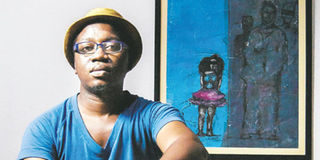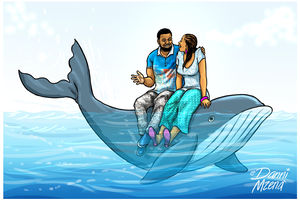Gadi’s ‘Giant and the girls’ show sparks conversation

Gadi Ramadhani poses for a photograph next to one of his works themed Giants and the Girls. PHOTO | ESTHER MNGODO
What you need to know:
- One of the outstanding issues at the exhibition is the fact that it has been put forward by a man
Gemma Todd stood in the middle of Sabrina and Cece and together, they keenly observed the painting hanging on the wall.
“The fact that this is a big man, and what looks like a very small woman next to him, represents male dominance, I think. She is fragile and vulnerable, while he is big and intimidating,” Gemma, a Dar es Salaam based researcher says to her friends who had other views.
That painting was among the 18 artworks exhibited at Oasis Cafe on Tuesday night by Gadi Ramadhani.
“This is exactly what I wanted. I wanted to start a conversation,” he said.
The exhibition themed ‘Giants and the Girls’ yet the individual artworks remain without a title since Gadi wanted to give a sense of freedom for interpretation.
“Giants and the Girls” is a story of a girl child, motivated by the recent cases in Tanzania regarding the legal age of marriage consent championed by Rebeca Gyumi, an activist in Dar es Salaam.
According to Nafasi Art Space’s Rebecca Yeong Corey art has a powerful role in starting important conversations because it speaks to our deepest hopes and fears and transcends the limitations of everyday speech.
“As humans, we’re unique in our ability and our need to express ourselves creatively. The metaphors and symbols that emerge from artwork provoke response and engagement with issues where direct statements often fail. Art can be both a reflection of who we are and a window into what we want to be. For this reason it can have a transformative effect, on the individual and society at large,” she said.
To which Gadi explains that sometimes the governing authority can be a hindrance in allowing artistic conversation.
He has a lot of artwork which he fears could appear controversial, since they challenge thinking and systems.
“I think that the government doesn’t understand the language of the arts. It isn’t to disrespect them but to share opinion,” he says.
However, this collection has managed to overcome that barrier. Rebecca explains that Gadi’s work in the “Giant and the Girls” addresses the oppressive ways women and girls are treated, from child marriage to domestic abuse. His critique of gender inequality is clear through the works.
“While as a man Gadi cannot claim to truly experience gender violence or oppression, he uses his voice and platform as an artist to show solidarity and support for women fighting for equality.
Through his work, Gadi is drawing attention to the issue in order to open up space and amplify the voices of women,” says Rebecca.
To further this conversation, there will be a special dialogue forum on child marriage and women’s rights tonight at Nafasi Art Space.
The event features Gadi’s works but it will be female gender activists and artists who will moderate and speak on the panel and this time not Gadi himself.
“But the fact that this conversation was started by a man, makes it even more interesting,” said Gemma.
“I think more men need to be in the discussion. I am glad he is raising issues on feminism and equality of the sexes. But it is a discussion that needs to be done by both men and women. A lot of the time, men are excluded. I love the fact that this is a man doing this,” she said.
Rebecca said, “I would say, in this conversation around child marriage and women’s rights, it’s not just the place of men to speak up, it’s their obligation as the decision to end such practices depend on the support and involvement of men.
The key point is they must work together with women to achieve this goal and not drown out the voices and efforts of women who are in fact leading the fight against gender violence and abuse.”
On the other hand, Adam Foya, a fashion designer, says that it’s not about labels. It is about action. “I am less concerned about a man being called a feminist. I want to see the change after the exhibition is over. Does the conversation continue in the office? Are women recognised for their contribution in the economy? These are the things that matter,” he says and adds, “The dialogue should not end with women.”




